Exploring Miyagi Wetlands
 All photos by the author
All photos by the authorThe wind was blowing hard across the open flat space as wearrived at Izu-numa. All boats had been stranded and moored by the lakeside. Thiswas a disappointment but understandable. I could see the bamboo thickets on thenorthern side of the lake bending in the wind while hawks soared above takingadvantage of the lift provided by the airflow.
Izu-numa is one of the wetlands in Miyagi Prefecture ofJapan, designated as a Ramsar Site. It’s located north of the prefecturalcapital of Sendai, which received some international fame during the 2011earthquake and tsunami that killed thousands of people and led to a partialmeltdown at the Fukushima nuclear plant. We had arrived from the oppositedirection, from Oshu in Iwate Prefecture just some 100 km further north on theJapanese mainland. I was traveling with a small group of friends from Oshu intheir van.
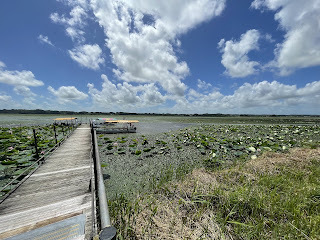
Instead of getting on a boat, we walked around the shorewhere the lake gave way, first, to a carpet of water lilies, then a brush ofreeds growing in the soft, muddy soil. Some birds, including a couple of egretswith their wings shiny white under the summer sun, took of from the undergrowthas they detected our approaching steps. The whole landscape was deep greenagainst a blue sky on which fluffy cumulus clouds traveled fast driven by thewind.
The lake, although shallow – 1.6 meters at its deepest point– is very rich in biodiversity. There are 40 fish species that have beenidentified in the lake. That is many more than in most freshwater lakes orponds. Several of these fishes belong to the family of carps. The lake and thesurrounding wetland is one of the most important wintering locations for birds,such as whooper swans, in Japan. It is estimated that 90 percent of the greaterwhite-fronted geese traversing Japan stop at the lake. All of 236 bird specieshave been identified in the area. The wetland is also well-known for its insectlife, especially that of dragonflies. For all these reasons, the Isu-numa –Uchi-numa wetland complex was the second in Japan to be designated a Ramsarsite in 1985, just after the Kushiro wetlands in Hokkaido. Wetlands are amongthe most productive and biologically rich ecosystems in the world. As such,they are also essential for human well-being.
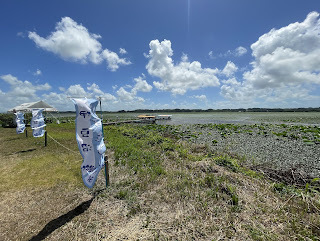 After spending time on the lake shores, we entered thewell-equipped Sanctuary Center on a knoll just above the wetland. Operated bythe Miyagi Prefectural Izunuma-Uchinuma Environmental Foundation, the modernbuilding is designed to resemble a white swan spreading its wings. Despite itssize, it fits well into the landscape, with large panoramic windows overlookingthe natural area. The Foundation engages in conservation, information andresearch work. The exhibits in the two-story hall were very interesting.Luckily for me, there was a staff member who was delighted to explain some ofit in fluent English to me.
After spending time on the lake shores, we entered thewell-equipped Sanctuary Center on a knoll just above the wetland. Operated bythe Miyagi Prefectural Izunuma-Uchinuma Environmental Foundation, the modernbuilding is designed to resemble a white swan spreading its wings. Despite itssize, it fits well into the landscape, with large panoramic windows overlookingthe natural area. The Foundation engages in conservation, information andresearch work. The exhibits in the two-story hall were very interesting.Luckily for me, there was a staff member who was delighted to explain some ofit in fluent English to me.The Ramsar Convention was adopted in 1971 and came intoforce in 1975. It is thus one of oldest modern international environmentalagreements. Its official name is the Convention on Wetlands and it provides aninternational framework for the conservation and wise use of these productivelandscapes that are extremely important for the preservation of biologicaldiversity, water and other assets that are essential for the survival of ourspecies. Ramsar is a city in Iran where the agreement was created. Since then,almost nine-tenths of the world’s countries have become “contracting parties”to the Convention. The United States has been a member since 1986 and boasts 41Ramsar sites, ranging from the Aleutian Islands and Hawaii to all over thecontinental lower 48 states.
Japan joined in 1980 and has all of 53 Ramsar sites, againranging from Hokkaido in the north to Okinawa in the south. Six of the sitesare in the Tohoku region, which comprises the northern segment of the mainisland, Honshu.
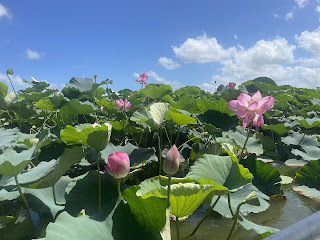
These include the Izu-numa and Uchi-numa National WildlifeProtection Area and Nature Protection Area covering 559 ha. Izu-numa and Uchi-numaare two interconnected freshwater lakes and their surrounding peat swamps inthe In the Hasama River basin. Outside of the protected area, agriculture andespecially rice cultivation prevails. The Hasama itself is a tributary of theKitakamigawa, the largest river in northern Japan and one of my absolutefavorites in the world, flowing from its origins at Mt. Nanashigure through Iwateand Miyagi prefectures until it reaches the Pacific Ocean.
The two lakes and wetlands have extensive reed beds and arecharacterized by submerged vegetation, including water lilies. The alluvialplain is also one of the very few locations in Japan where wild rice grows,providing important nutrition to visiting waterfowl. Numerous species ofAnatidae — ducks, geese, swans and related water birds — winter in the Izu-numa/ Uchi-numa area. Already in 1967, the Government of Japan designated the area’sbirdlife and habitat as a National Monument. One of the curiosities thatdemonstrates the closeness of the Japanese people and nation to nature is thedesignation of national soundscapes. In 1996, the call of the greaterwhite-fronted goose (Anser albifrons) was selected as one of the 100Soundscapes of Japan by the MInistry of Environment (in another blog, Imentioned that the wind chimes at Mizusawa train station are also designated assuch).
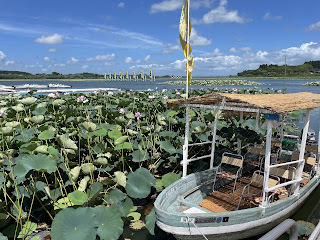 Current Ramsar-related research in the area focuses on thedeclining growth of wild rice and the wintering bird populations. Some ofthis research – and conservation action – is conducted by the Izunuma-UchinumaEnvironmental Foundation, which engages in prevention of further shallowing ofthe lakes, eradication of harmful invasive species (like the largemouth bass),planting wild rice, and clearing excessive reed beds.
Current Ramsar-related research in the area focuses on thedeclining growth of wild rice and the wintering bird populations. Some ofthis research – and conservation action – is conducted by the Izunuma-UchinumaEnvironmental Foundation, which engages in prevention of further shallowing ofthe lakes, eradication of harmful invasive species (like the largemouth bass),planting wild rice, and clearing excessive reed beds.Leaving Izu-numa and its excellent information center, wecircled the lake by its eastern end, exiting the nature protection area. Ournext destination was Naga-numa, another shallow lake of similar size and oblongshape. It is located about 10 km southeast of Izu-numa and Uchi-numa in thetown of Tome. At the entrance to thelake there is a park, Naganuma Futopia Park, with its landmark Dutch windmillerected in 1991.
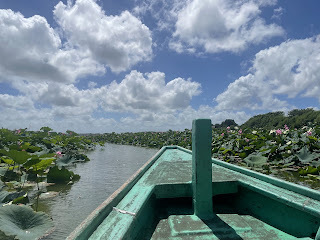 Luckily for us, the wind had abated and we were able to finda boater who would take us on the lake. We entered the small vessel coveredwith a canopy made of reeds. Even more than Izu-numa, Naga-numa was almostentirely covered by water lilies, except for two open water areas, in front ofthe small boat harbor and the center of the lake. The local boatmanexplained that this summer there were more water lilies than ever in the pastdecade.
Luckily for us, the wind had abated and we were able to finda boater who would take us on the lake. We entered the small vessel coveredwith a canopy made of reeds. Even more than Izu-numa, Naga-numa was almostentirely covered by water lilies, except for two open water areas, in front ofthe small boat harbor and the center of the lake. The local boatmanexplained that this summer there were more water lilies than ever in the pastdecade.Traversing the water lily beds, the boat gained speedentering the open water until we reached the other side of the lake where thelilies floated thick in a wide stretch. We lingered a good while, floatingamongst the beautiful red flowers and large green leaves. The day was hot and sunnybut there was a cooling breeze on the water. I felt very calm and satisfiedwith our outing in the beautiful and unique nature.
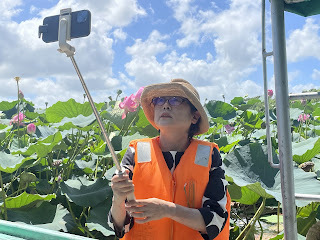 My friends taking a selfie among the Lotus
My friends taking a selfie among the Lotus



